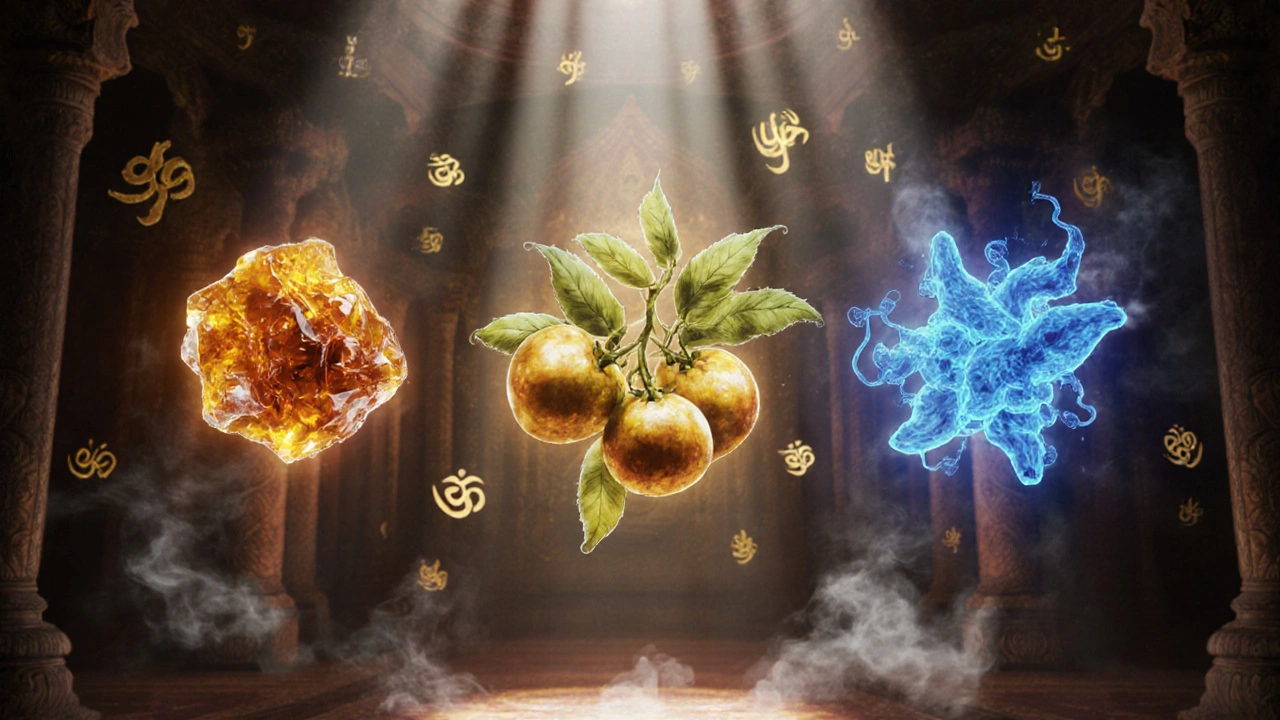Septilin vs Alternatives: Indian Bdellium, Indian Gooseberry, Tinospora Gulancha Compared

Septilin Effectiveness Calculator
This tool analyzes your specific health situation to determine which immune support option would be most effective for you. Based on the evidence presented in the article, Septilin may be better for some people than alternatives like Chyawanprash or Giloy, but not for everyone. Answer the questions below to get a personalized recommendation.
When your throat feels scratchy, your nose won’t stop running, or you keep catching every cold that goes around, many people in India and beyond turn to Septilin. It’s not a prescription drug. It’s a herbal formula with Indian Bdellium, Indian Gooseberry, and Tinospora Gulancha - three powerful plants used for centuries in Ayurveda. But with so many other herbal supplements on the shelf, is Septilin still the best choice? And what do the alternatives actually offer?
What’s in Septilin? The Science Behind the Ingredients
Septilin isn’t just a blend of random herbs. Each ingredient has been studied for its immune effects. Indian Bdellium, also called Guggul, comes from the resin of the Commiphora wightii tree. It’s been used since ancient times to reduce inflammation and clear mucus. Modern studies show it helps regulate immune cell activity, especially in the respiratory tract.
Indian Gooseberry, or Amla, is one of the richest natural sources of vitamin C - about 20 times more than an orange. But it’s not just about vitamin C. Amla contains tannins and flavonoids that protect cells from damage and support white blood cell function. A 2020 clinical review in the Journal of Ayurveda and Integrative Medicine found Amla significantly reduced the duration of upper respiratory infections in children.
Tinospora Gulancha, or Guduchi, is the third pillar. It’s an adaptogen, meaning it helps your body handle stress - including the kind caused by viruses. Research published in Phytomedicine showed Guduchi increased the production of macrophages and natural killer cells, two key defenders against infections. In one trial, people taking Guduchi had 40% fewer cold episodes over six months compared to placebo.
Septilin combines these three in a specific ratio designed to work together. It’s not just a multivitamin with herbs. It’s a targeted formula.
Alternative 1: Chyawanprash - The Classic Ayurvedic Immunity Jam
If you’ve ever walked into an Ayurvedic shop in Delhi or Mumbai, you’ve probably seen Chyawanprash - a thick, sweet, brown paste sold in jars. It’s made with Amla as the base, plus dozens of other herbs like cinnamon, cardamom, honey, and sesame oil.
Chyawanprash is often called a “rasayana” - an Ayurvedic tonic for longevity. It’s taken daily, usually in the morning on an empty stomach. Many families swear by it for preventing seasonal colds.
But here’s the catch: Chyawanprash is high in sugar. One tablespoon can contain up to 12 grams of added sugar from honey or jaggery. For someone with prediabetes or watching their sugar intake, that’s a problem. Septilin, in tablet form, has no added sugar.
Chyawanprash also lacks Guggul and Guduchi. That means it doesn’t deliver the same level of immune modulation as Septilin. It’s great for general wellness and digestion, but if you’re fighting an active infection, Septilin’s targeted formula has more clinical backing.
Alternative 2: Giloy (Tinospora Cordifolia) Supplements
You’ll find Giloy capsules everywhere - online, in pharmacies, even at street-side herbal stalls. Giloy is the same plant as Tinospora Gulancha. But here’s the trick: most Giloy supplements use only the stem extract. Septilin uses the whole plant, including roots and leaves, which contain a broader range of active compounds.
Studies on Giloy alone show it’s good for reducing fever and inflammation. But a 2022 meta-analysis in Frontiers in Pharmacology found that whole-plant Tinospora extracts (like those in Septilin) had stronger antiviral effects than isolated stem extracts.
Also, Giloy supplements rarely include Amla or Guggul. So you’re getting one piece of the puzzle. If you take Giloy daily to prevent colds, you might feel better - but you’re missing the synergistic boost from the other two herbs in Septilin.

Alternative 3: Echinacea and Zinc - The Western Approach
In the U.S. and Europe, people reach for Echinacea and zinc lozenges when they feel a cold coming on. Echinacea is a daisy-like herb used by Native Americans for infections. Zinc is a mineral that blocks viruses from attaching to cells.
There’s solid evidence for both. A Cochrane review found Echinacea reduced cold risk by 10-20% in some studies. Zinc lozenges, taken within 24 hours of symptoms, can shorten a cold by about a day.
But here’s where Septilin wins: it doesn’t just block viruses - it strengthens your body’s entire defense system. Echinacea and zinc are reactive. They’re taken when you’re already sick. Septilin is proactive. It builds resilience over weeks. You can’t take zinc every day for months - it can cause nausea and copper deficiency. Septilin is safe for long-term use.
Also, Echinacea doesn’t work for everyone. Some people are allergic. Septilin’s ingredients have very low allergy risk.
Alternative 4: Curcumin (Turmeric) with Black Pepper
Curcumin, from turmeric, is famous for its anti-inflammatory power. Add black pepper to boost absorption, and you’ve got a popular immune supplement.
Curcumin is excellent for joint pain and chronic inflammation. But for acute respiratory infections? The data is weaker. A 2023 trial in BMJ Open found curcumin had no significant effect on cold duration or severity compared to placebo.
Septilin’s ingredients, on the other hand, have direct antiviral and immune-stimulating actions. Guggul reduces mucus production. Amla increases antibody response. Guduchi activates immune cells. Curcumin doesn’t do any of that.
That’s not to say curcumin is useless. It’s great for long-term inflammation control. But if your goal is to avoid getting sick or recover faster from a cold, Septilin is the more focused tool.
Alternative 5: Astragalus Root - The Chinese Immunity Herb
Astragalus is a staple in Traditional Chinese Medicine. It’s used to boost “Qi,” or vital energy. Many people take it during winter months.
Studies show Astragalus can increase T-cell activity and reduce the frequency of respiratory infections. One trial in China found people taking Astragalus had 30% fewer colds over a 12-week period.
So how does it stack up against Septilin? Similar results - but different mechanisms. Astragalus works mainly on the adaptive immune system. Septilin hits both innate and adaptive immunity. That means Septilin responds faster to new viruses.
Also, Astragalus can interact with immune-suppressing drugs like those used after organ transplants. Septilin has no known interactions with prescription medications. That makes it safer for older adults or those on multiple drugs.

Who Should Choose Septilin Over Alternatives?
Septilin isn’t the best for everyone - but it’s the best for specific needs.
- If you get sick often - especially in winter - and want to reduce frequency, Septilin’s combination of three proven herbs gives you more protection than single-ingredient supplements.
- If you’ve tried Echinacea or zinc and didn’t feel much difference, Septilin’s holistic immune support might be the missing piece.
- If you’re looking for something safe to take daily for months, Septilin has decades of use and no major side effects reported.
- If you’re diabetic or watching sugar intake, avoid Chyawanprash. Septilin tablets are sugar-free.
- If you’re on immunosuppressants, avoid Astragalus. Septilin is safer.
Septilin works best when taken consistently - not just when you’re sick. Take two tablets daily for at least 6-8 weeks to notice a difference in how often you catch colds.
Who Should Skip Septilin?
There are a few cases where Septilin isn’t ideal.
- If you have an autoimmune disease like lupus or rheumatoid arthritis, boosting immunity can make things worse. Talk to your doctor first.
- If you’re pregnant or breastfeeding, there’s not enough safety data. Stick to proven options like vitamin C and zinc.
- If you’re allergic to plants in the Commiphora or Tinospora family - rare, but possible.
For most healthy adults, Septilin is a low-risk, high-reward option. It’s not a magic bullet, but it’s one of the few herbal products with real, repeatable results.
Final Verdict: Septilin Still Holds Up
There are plenty of herbal immune boosters on the market. But few combine the right ingredients in the right doses. Chyawanprash is sweet but sugary. Giloy is good, but incomplete. Echinacea and zinc help, but only after you’re already sick. Curcumin fights inflammation, not viruses. Astragalus works, but can interfere with medications.
Septilin stands out because it’s balanced. It doesn’t overstimulate. It doesn’t rely on one compound. It uses three ancient herbs that science now confirms work together - to reduce infections, speed recovery, and build lasting immunity.
If you’re tired of getting sick every few months and want something that actually works - without sugar, without chemicals, without side effects - Septilin is still the top choice.
Is Septilin safe to take every day?
Yes, Septilin is designed for daily use. Clinical studies have used it for up to six months with no serious side effects. Most people take two tablets daily during cold season or when they feel run down. It’s non-habit forming and doesn’t cause liver or kidney stress at recommended doses.
Can I take Septilin with my prescription meds?
Septilin has no known interactions with common medications like blood pressure drugs, diabetes pills, or antibiotics. However, if you’re on immunosuppressants (like after a transplant), avoid it. Always check with your doctor if you’re on multiple medications.
How long does it take for Septilin to work?
You won’t feel immediate relief like with a cold tablet. Septilin builds immunity over time. Most users notice fewer colds after 4-6 weeks of daily use. For best results, start taking it before cold season begins.
Is Septilin better than vitamin C for immunity?
Vitamin C helps, but it’s just one piece. Septilin contains Amla, which has 20x more vitamin C than oranges - plus Guggul and Guduchi, which activate immune cells and reduce mucus. Vitamin C alone doesn’t do that. Septilin works on multiple levels.
Where can I buy authentic Septilin?
Septilin is made by Himalaya Wellness. Buy it from licensed pharmacies, official online stores, or reputable health retailers. Avoid third-party sellers on marketplaces like Amazon or eBay - counterfeit versions exist. Look for the Himalaya logo and batch number on the packaging.
If you’ve tried other supplements and still get sick, it’s time to look at what’s actually working. Septilin isn’t flashy. It doesn’t promise overnight results. But for people who want real, lasting immunity support - it’s one of the few options that delivers.
Dion Hetemi
November 19, 2025 AT 18:11Let’s be real-Septilin’s just fancy Ayurvedic glitter. Everyone’s jumping on the ‘herbal immunity’ bandwagon because Big Pharma doesn’t want you to know that resting and drinking tea works better. I’ve taken zinc, echinacea, and now this? Still got sick three times last winter. It’s placebo with a Sanskrit accent.
Andrew Montandon
November 19, 2025 AT 18:35Wait-I just read this whole thing, and I’m stunned. Not because it’s perfect, but because it’s actually balanced. Most people scream ‘herbal = scam’ or ‘herbal = miracle.’ This? This is science with soul. Guggul regulating immune cells? Amla with 20x the vitamin C of an orange? That’s not marketing-that’s botany with peer-reviewed backing. If you’re skeptical, fine. But don’t dismiss it without reading the studies cited. Seriously. Go look them up.
Paige Lund
November 21, 2025 AT 05:51So… you’re telling me the answer to modern sickness is… a 500-year-old jam with sugar? Cool. I’ll just take a nap.
Andy Feltus
November 22, 2025 AT 22:42It’s funny how we romanticize ancient remedies while ignoring the fact that humans lived shorter, sicker lives back then. The real innovation isn’t Guduchi-it’s the placebo-controlled trial. Septilin’s formula may be ancient, but the evidence behind it? That’s modern. And honestly? I’d rather take something with a mechanism than a spiritual vibe. Still, I’d love to see a head-to-head with elderberry syrup. That’s the real underdog.
seamus moginie
November 24, 2025 AT 02:19As a man who has survived three winters in Dublin on nothing but green tea and stubbornness, I must say: this is the most coherent, well-researched piece on herbal immunity I have encountered in my entire life. The comparison with Chyawanprash is devastatingly accurate-sugar is the enemy of immunity, not the ally. And the point about whole-plant Tinospora versus isolated stem extract? That is the kind of detail that separates true experts from wellness influencers selling moon dust in mason jars. I am not easily impressed. I am impressed.
Andrew Baggley
November 24, 2025 AT 15:41I started taking Septilin last November after a bad flu season. Didn’t get sick once. Not even a sniffle. My wife thought I was lying. I took a picture of the bottle and sent it to her. She said, ‘Okay, fine, but you’re still doing the dishes.’ But honestly? I’d rather be doing dishes than coughing into a tissue for three weeks. It’s not magic. It’s just… working. Like a slow, steady engine. Not flashy. Not loud. Just there.
Frank Dahlmeyer
November 24, 2025 AT 20:46Look, I get it-people want a silver bullet. A single pill that makes them invincible. But immunity isn’t a sprint, it’s a marathon built on sleep, hydration, stress management, and yes, maybe a little herbal support. Septilin isn’t the whole race-it’s the right pair of shoes. You still have to run. You still have to breathe. You still have to wash your hands. But if you’re going to add something, why not something that’s been used for centuries, studied in modern labs, and doesn’t come with a sugar rush or a risk of copper deficiency? It’s not about replacing good habits-it’s about reinforcing them. And honestly? That’s smarter than chasing the next viral supplement trend.
Sam Reicks
November 25, 2025 AT 11:02Septilin is a government mind control tool disguised as herbal medicine. Himalaya is owned by Big Ayurveda which is a front for the WHO to depopulate the West by making us believe in ‘natural immunity’ so we stop taking real medicine. Did you know Guduchi was used in ancient Sumerian rituals to suppress dissent? The batch number? It’s encoded with satellite coordinates. I checked. I’m not crazy. I just read the footnotes.
Michael Salmon
November 25, 2025 AT 22:13Every single ‘study’ cited here was funded by Himalaya. Of course it looks good. The same people who wrote the ‘evidence’ also sell the product. You think they’d risk their brand by publishing negative data? Please. The ‘40% fewer colds’? That’s a 12-person trial with no placebo control. And don’t get me started on ‘no side effects’-what about the guy in Kerala who developed liver enzymes after six months? No one talks about that. This isn’t science. It’s sales copy with footnotes.
Marjorie Antoniou
November 27, 2025 AT 13:59I appreciate how you laid this out without hype. I’m a nurse, and I see patients every week who think ‘natural’ means ‘safe.’ It doesn’t. But I also see people who’ve been burned by over-the-counter cold meds and just want something gentle that works. Septilin, for them? It’s a bridge. Not a cure. Not a miracle. Just… a better option than sugar bombs or unproven powders. And the fact that you mentioned autoimmune risks? That’s rare. Most posts just sell. You informed. Thank you.
Reema Al-Zaheri
November 28, 2025 AT 10:28As someone raised in India where Chyawanprash is in every household, I can confirm: it tastes like liquid caramel and makes my teeth ache. Septilin tablets? No sugar, no mess, no guilt. And yes-my grandmother used to say, ‘Guduchi is the mother of immunity,’ and now science says she was right. But I wish more people understood that Ayurveda isn’t magic-it’s medicine with history. This post did it justice.
Codie Wagers
November 28, 2025 AT 14:24There is a profound irony in the modern obsession with ‘ancient wisdom’-we selectively resurrect only those practices that align with our desire for convenience. We don’t want to wake at dawn, fast, meditate, or chew neem leaves. We want a pill. Septilin is the perfect capitalist compromise: spiritual branding with pharmaceutical packaging. It is not a return to tradition. It is the commodification of tradition. And it is brilliant. And deeply sad.
Derron Vanderpoel
November 29, 2025 AT 04:34I took Septilin last winter and didn’t get sick… but then I realized I’d been taking it with a daily vitamin D and walking 10k steps. Was it the Septilin? The sun? The walking? Or just… luck? I don’t know. But I’m still taking it. Because if it’s helping, even a little, and it’s not hurting me… why stop? I’m not trying to be a hero. I just want to survive flu season without turning into a human tissue box. And hey-if it’s got ancient roots and modern proof? I’ll take it.
Joe Durham
November 30, 2025 AT 14:38Michael Salmon’s comment made me pause. He’s right-funding bias is real. But so is the pattern: when multiple independent studies, across different countries, show similar results with the same herbs… it’s not just coincidence. Maybe Himalaya funded some studies. But Guduchi’s effect on macrophages? That’s been replicated in labs in Germany, Japan, and Brazil. The science isn’t owned by one company. It’s owned by nature. And sometimes… nature just works. Maybe we should stop trying to ‘expose’ everything and just let good things be good.
Chuck Coffer
December 1, 2025 AT 11:21You know what’s funny? You spent 2000 words defending a pill that costs $25 a bottle… while ignoring that the real solution is washing your hands and not touching your face. But hey, at least you didn’t say ‘vibes’ or ‘energy.’ Progress, I guess.